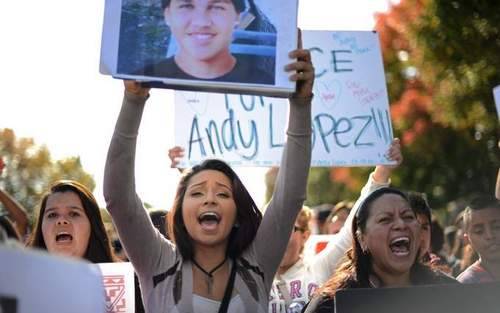 On October 29, hundreds of young people march through downtown Santa Rosa, Cali., protesting the death of Andy Lopez, a 13-year-old boy gunned down by Sonoma County police. – Photo by Erik Castro/for the Press Democrat
On October 29, hundreds of young people march through downtown Santa Rosa, Cali., protesting the death of Andy Lopez, a 13-year-old boy gunned down by Sonoma County police. – Photo by Erik Castro/for the Press Democrat
Andy Lopez, Police Brutality, and Silencing Youth Anger
By Raven Rakia
Police brutality resistance has sprung up in Santa Rosa, California. In October and November, the town saw marches, forums and meetings to address the police slaying of a 13-year-old boy.
On October 29, the first march, hundreds of kids walked out of school and met on the streets. They were there for Andy Lopez, the 13-year-old boy who was shot seven times within 10 seconds by sheriff deputy Erick Gelhaus for holding a toy gun. He was declared dead on the scene. As I watched the protest, I saw kids marching with focus and determination. You could hear the frustration and rage behind their chants: “No justice! No peace! Fuck the police!”
They were marching to the main rally where thousands of supporters were gathering before marching to the sheriff’s office. However, when the kids reached the rally, the mood fell stagnant. While hundreds of kids had just walked out of class, only adults were speaking into the mic. When a young person shouted out “Fuck the police,” one of the organizers who had the mic at the time immediately responded and said, “We’re not going to have any of that here because that type of ignorance leads to violence.”
His lecture wasn’t over, the organizer decided to educate the group of young people by saying “When you say fuck the system, you’re really saying fuck yourselves because you are the system” (since when?) and “You want to change the system? Become a police officer changes it from the inside.” As the rally ended and the crowd headed towards the sheriff’s office, a reminder to keep the march “peaceful” was announced at five minute intervals until the end of the march.
Not only did the organizer silence and dismiss the anger of young people that day, he gave advice that was harmful in its inaccuracy. Through slavery and genocide, both the economic and political American system were established while simultaneously excluding Indigenous and Black people not only as citizens, but as full human beings. Two hundred and fifty years later, people of color are actively pushed out of the economic system by corporate and political elites at alarming rates – whether it’s the school to prison pipeline, the prison industrial complex, home evictions, public school closings or immigration deportations.
When Chicago closed a record number of 129 public schools this year, 90 percent of the students affected were Black and when Washington D.C. closed 15 public schools, 99.9 percent of the 2,700 affected students were people of color. Obama has deported more people than any other president: 1.5 million undocumented immigrants, mostly Latino and Black. Youth unemployment for Black men is 22.1 percent – double the national average and the most likely demographic to be evicted from their homes are Black women. To say that young people of color are a part of the economic or political system in America, is quite frankly (and for lack of a better word), bullshit.
The neoliberal concept that oppressed people of color can change the system simply by becoming a part of it proves to be deceitful. With the changing demographics of America, the bipartisan political elite are forced to change their tactics. While the Republican party is trying to hold onto power by restricting voting rights that will predominantly affect people of color, the Democratic party is pushing prominent individuals of color and women into the limelight in order to maintain their power through electoral politics – but that doesn’t mean either party’s policies will be any less damaging for the majority of people of color in or outside of the United States. As William C. Anderson notes in “Changing The Hue of Hegemony,” when people of color join the system (whether it be the police force or politics), more often than not we see them carrying out the same oppressive policies of their white predecessors. This tactic of silencing the oppressed, and encouraging them to simply try harder to join mainstream society in order to bring about change serves the same oppressive system that killed Andy Lopez.
Older generations’ attempt to police youth behavior and suppress youth anger in the face of police brutality is not uncommon. When 16-year-old Kimani Gray was killed by police last March, multiple adults publicly asked the young people that took to the streets to calm down and “stop rioting.” The result? A week of nightly protests that drew hundreds and mobilized with the greatest momentum seen in New York City since Troy Davis was murdered, fell off. Statistics that I stated earlier reveal that a national youth-led racial justice movement is not only necessary but critical for our survival. Although some may say it is long overdue, there have been positive signs that we’re now witnessing the beginning of one. But when young people speak out and stand up, they are often silenced by the same adults in the community that claim to have their best interests in mind.
Through the colonial gaze, not only are Black and Brown people already associated with violence at first glance, the violence committed by the darker-skinned is never put into context but immediately dismissed as barbaric and ignorant. Politicians speak out against gun and gang violence in the American ghettos in Philadelphia, Chicago and Baltimore but we don’t hear about the American apartheid system created and sustained by bank institutions and our own government, resulting in Black ghettos. We will see images of riots in Oakland but no images of the police brutality plaguing Black neighborhoods nationwide and no talk of the War on Drugs that brought in a militarized police occupation to these neighborhoods. The media will give you a body count in Chicago but won’t tell you about the lack of job opportunities (and employment discrimination), the closing down of mental health services and community centers, and the defunding of public schools. In New York, Mayor Bloomberg and Ray Kelly discuss gun and gang violence as an excuse for police occupation and harassment in poor neighborhoods but never mention that Bloomberg defunded and shut down after school programs for more than 41,000 New York children – most of which were in those same poor neighborhoods with the highest stop and frisk statistics.
As Chicago-based Gender Just says in their letter on Trayvon Martin and the Zimmerman acquittal:
We…ask that we stop thinking about violence as only connected to the possession of guns. Violence is intimately connected to the abandonment of neighborhoods, the defunding of public libraries and public schools, the closure of mental health clinics, and this city’s plantation racism.
Many studies have outlined the connection between violence and unemployment and violence and the lack of basic resources - but they’re conveniently ignored by the media, and more importantly, by policymakers.
Making these connections and providing this context is vital for anyone interested in racial justice. Decontextualizing Black violence serves as a tool to not only deplete the resources in Black neighborhoods but to also over-police our neighborhoods and push youth of color into the prison system. There is no doubt that this is the same tool that allows police officers to kill young Brown and Black men without consequence.
Michelle Alexander ends her book on mass incarceration and the drug war, The New Jim Crow, by saying, “Those of us who hope to be their allies should not be surprised, if and when and this day comes…what we hear is rage. The rage may frighten us. It may remind us of riots, uprisings, and buildings aflame. We may be tempted to control it or douse it with buckets of doubt, dismay or disbelief. But we should no such thing.” As it was the very last page, Alexander never went into detail about why refusing to dismiss rage is important. And in this day and age – when high-profile (and rich) Black people ask the youth publicly to “stay calm” and “peaceful” after the Zimmerman trial verdict – it is a conversation worth having.
When we dismiss warranted youth anger in the face of police brutality as “ignorant” and “violent” we are looking at them through the same gaze as their oppressors. More than that, we are serving the same system that is actively oppressing our communities. We are building up and continuing exactly what we claim to be fighting. Stripping away colonial tactics and mindsets is necessary to creating the communities we hope for, and to struggling towards living free from oppression.
In Santa Rosa, the kids fought back. They continued to yell “fuck the police” in unison even after adults dismissed their anger for ignorance. As the adults dominated the microphone emphasizing the need to remain peaceful, the kids gathered in circles, chanting, yelling and holding their own speak outs. However, It is hard to tell if the actions at the march will have discouraged some kids from participating in futures marches and movements. Attempting to tranquilize youth is not only harmful to kids’ psyches and our communities but can damage youth justice movements.
While the protests have seen a decrease in numbers, some of the young people in Santa Rosa aren’t giving up that easily. Instead, they’ve taken it upon themselves to organize their own actions including the last march on November 26 which involved acts of civil disobedience as they blocked traffic and a flash mob protest on November 30, Black Friday. They kept the location of the flash mob a secret, only sharing the place where they’ll meet up and asked everyone to “wear a shirt over (their) Andy Lopez shirt” when heading to the location.
As adults speak over kids with misguided advice, they should expect to get left behind. Many adults that day, claimed they were just trying to keep the young people safe. While their intentions may have been genuine, it is not merely a coincidence that this is often the same excuse for police occupation and racial profiling in our neighborhoods.
—-
Raven Rakia is a writer, filmmaker currently working on a documentary about Kimani Gray. Follow her on Twitter, @aintacrow
Raven Rakia
freelance journalist. filmmaker: @kimanifilm, @1181documentary. #witchbloc nappy hair, never cared.
Catch up with me @aintacrow.

